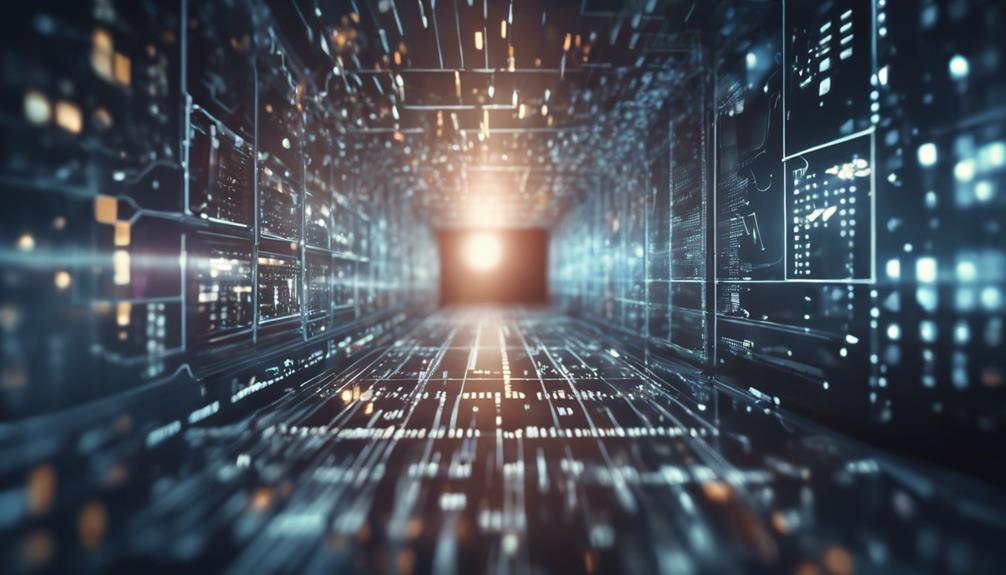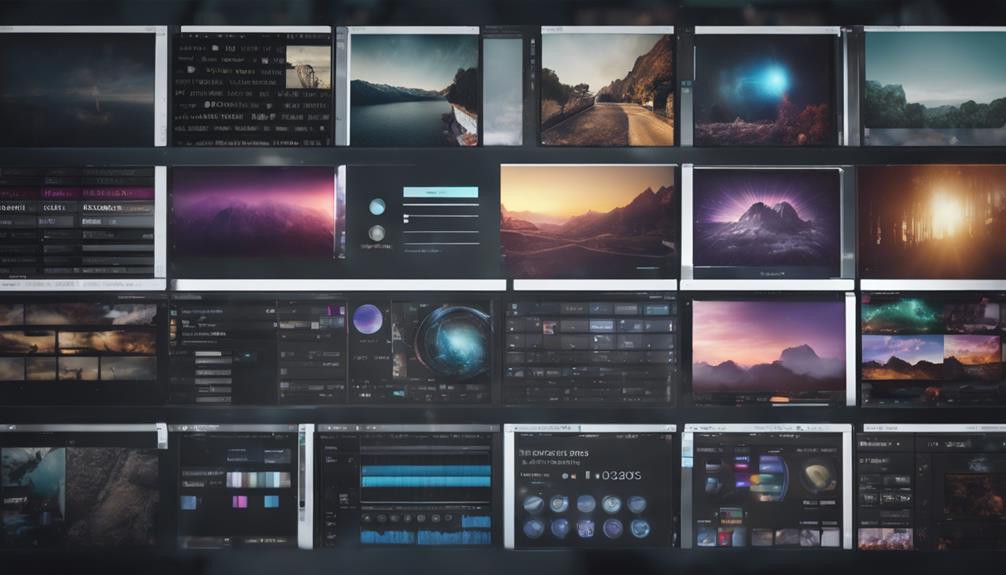Explore the realm of video data processing techniques with the top 10 sought-after techniques that are revolutionizing the way video content is analyzed and optimized. From segmentation to object recognition, these methods hold the key to unlocking valuable insights from video data. As you delve into each technique, you’ll discover how they impact industries across the board, making them essential tools for enhancing video content and ensuring compliance with data regulations. Stay tuned to uncover the intricate details behind these cutting-edge approaches and their implications in today’s data-driven world.
Video Segmentation
To effectively analyze and understand video content, video segmentation is a crucial process that involves partitioning a video into distinct segments based on various visual features. Motion detection plays a key role in video segmentation by identifying areas in the video where motion occurs. This technique helps in distinguishing moving objects from the static background, enabling the segmentation process to isolate these regions accurately.
Background subtraction is another fundamental aspect of video segmentation. By differentiating the background elements from the foreground objects that are in motion, background subtraction aids in creating boundaries between different segments within a video. This method is essential for detecting changes in the scene and extracting relevant information for further analysis.
Video Summarization
Video summarization techniques condense lengthy video content into shorter representations by selecting key frames or segments that capture the most important information. Keyframe selection plays a vital role in this process, as it involves identifying frames that best represent the content of the entire video. Video compression techniques are often applied to further reduce the size of the summarized video without significant loss of important visual information.
Shot boundary detection is another crucial aspect of video summarization. By detecting changes in scenes or camera angles, shot boundaries help in segmenting the video into meaningful parts for summarization. This step aids in identifying significant transitions within the video, which can then be used to create a more concise summary.
In addition to keyframe selection and shot boundary detection, video summarization can also benefit from the use of video annotation methods. These methods involve adding metadata or labels to the video content, making it easier to understand and navigate the summarized version. Incorporating these techniques enhances the efficiency and effectiveness of video summarization processes.
Video Object Recognition
Implementing advanced algorithms for object recognition in videos enhances the capability of automated systems to accurately identify and track specific objects throughout video sequences. Video object localization involves pinpointing the exact location of objects within a video frame, while feature extraction focuses on extracting meaningful information from these objects to enable recognition. Motion analysis plays a crucial role in video object recognition by detecting movement patterns and understanding object trajectories. By analyzing the motion of objects within a video, systems can distinguish between normal behaviors and anomalies, leading to effective anomaly detection. Anomaly detection is vital for recognizing unexpected or unusual occurrences within a video, aiding in various applications such as surveillance and activity monitoring. Through the integration of these key techniques, video object recognition can significantly enhance the efficiency and accuracy of automated systems in identifying and tracking objects in dynamic video environments.
Video Object Tracking
Enhancing the capabilities of automated systems, video object tracking involves continuously monitoring and predicting the movement of specific objects across successive frames in a video sequence. Motion tracking accuracy is a crucial aspect of video object tracking, as it determines how precisely an object’s movement can be followed throughout the video. Achieving high motion tracking accuracy requires robust algorithms that can handle occlusions, changes in lighting conditions, and various object scales and rotations.
Real-time tracking challenges often arise in video object tracking, where the system must process frames quickly and efficiently to provide timely tracking results. These challenges include the need for fast computation to keep up with the video’s frame rate, handling multiple object tracks simultaneously, and adapting to sudden changes in object speed or direction. Overcoming real-time tracking challenges involves optimizing algorithms for speed and efficiency, utilizing parallel processing techniques, and implementing predictive models to anticipate object movements in the video sequence. By addressing these challenges, video object tracking systems can provide accurate and timely tracking results for various applications.
Video Pattern Detection
Detecting patterns within video data involves analyzing and identifying recurring visual motifs or sequences that provide valuable insights for various applications. Motion analysis is a key component of video pattern detection, focusing on understanding how objects move within a scene over time. By tracking the movement of objects frame by frame, patterns such as direction, speed, and acceleration can be identified, aiding in tasks like activity recognition and anomaly detection.
Behavior prediction is another crucial aspect of video pattern detection, where machine learning algorithms are employed to forecast future actions based on observed behaviors. By recognizing patterns in how individuals or objects behave in specific contexts, predictive models can estimate potential future actions, enabling proactive decision-making in surveillance, traffic management, and predictive maintenance scenarios.
In essence, video pattern detection leverages motion analysis and behavior prediction to uncover meaningful insights from video data, empowering various industries with valuable information for improving processes and enhancing security measures.
Video Event Detection
You need to address Object Recognition and Action Classification in the context of Video Event Detection. These points are crucial for identifying and categorizing events within video data. Object Recognition focuses on identifying specific objects within a video frame, while Action Classification categorizes the actions being performed in the video.
Object Recognition
One crucial aspect of video data processing techniques involves the accurate identification and tracking of objects in a sequence, a process known as object recognition for video event detection. Object detection accuracy is paramount in ensuring that the system can correctly identify and locate objects of interest within the video stream. Real-time object recognition is essential for applications where immediate action or response is required based on the detected objects.
To achieve high object detection accuracy, advanced algorithms such as convolutional neural networks (CNNs) are commonly employed. These algorithms analyze the visual features of objects to accurately classify and locate them within the video frames. Additionally, techniques like region-based convolutional neural networks (R-CNNs) and You Only Look Once (YOLO) models have been developed to improve the speed and efficiency of real-time object recognition systems.
Action Classification
Moving from object recognition to action classification in video data processing involves analyzing and categorizing specific movements or behaviors within the video stream, known as video event detection. When it comes to action classification, achieving high accuracy in action recognition is crucial. Deep learning models have significantly advanced the field of action classification by enabling the automatic learning of intricate features and patterns from video data.
Deep learning models, such as Convolutional Neural Networks (CNNs) and Recurrent Neural Networks (RNNs), have shown remarkable success in action classification tasks. These models can effectively capture temporal dependencies and spatial information within video sequences, leading to improved action recognition accuracy. By training these models on large-scale annotated video datasets, they can learn to differentiate between various actions and activities with high precision.
Video Semantic Analysis
You can explore the realm of Video Semantic Analysis by focusing on Object Recognition, Action Classification, and Scene Understanding. These three key points play a crucial role in deciphering the content and context of video data. Object Recognition identifies and labels elements, Action Classification categorizes movements, and Scene Understanding delves into the overall environment.
Object Recognition
Utilizing advanced algorithms, object recognition in video data processing involves the accurate identification and tracking of specific objects within a video stream for enhanced video semantic analysis. Image recognition plays a pivotal role in object recognition by enabling systems to detect and classify objects based on visual input. Machine learning algorithms, particularly deep learning models like convolutional neural networks (CNNs), have significantly advanced object recognition capabilities by automatically learning features from data and making intelligent predictions.
In object recognition, CNNs excel at extracting intricate patterns and features from images, allowing for precise object identification and tracking in videos. Through the process of training on vast amounts of labeled data, these models can generalize well to recognize objects in diverse video scenarios accurately. Object recognition is crucial for tasks like video surveillance, autonomous driving, and content-based video retrieval, where the ability to identify and track objects in real-time is essential for making informed decisions. The synergy between image recognition and machine learning continues to drive innovations in object recognition, enhancing video semantic analysis capabilities.
Action Classification
Action classification in video semantic analysis involves categorizing and identifying specific human actions within a video sequence to extract meaningful insights for various applications. To achieve this, action recognition algorithms play a crucial role in analyzing and interpreting the dynamics of human movements. Deep learning models have significantly advanced the field of action classification by enabling more accurate recognition and classification of actions in videos. These models have shown remarkable performance in capturing complex patterns and features within video data, leading to improved accuracy and efficiency in action classification tasks.
Performance evaluation of action classification systems is essential to assess the effectiveness and reliability of the algorithms implemented. Real-time implementation of deep learning models for action classification is a current focus, aiming to enable swift and accurate action recognition in live video streams. By leveraging the capabilities of deep learning and optimizing real-time processing, action classification systems can be applied in various domains such as surveillance, sports analytics, and human-computer interaction, enhancing automation and decision-making processes.
Scene Understanding
The advancement of deep learning models has revolutionized the field of video semantic analysis, particularly in the realm of scene understanding. Scene understanding involves the interpretation of video content to discern the context and elements present within a scene. This process encompasses scene reconstruction, where the system reconstructs the spatial layout, objects, and relationships within the scene, and scene prediction, which involves anticipating future actions or events within the video.
Scene analysis is a crucial component of video data processing, as it enables machines to comprehend the visual information presented in videos accurately. By leveraging deep learning techniques such as convolutional neural networks (CNNs) and recurrent neural networks (RNNs), researchers have made significant strides in enhancing scene understanding capabilities. These models can effectively segment objects, identify spatial relationships, and predict scene developments over time.
Video Content Extraction
Extracting video content involves identifying and isolating specific elements within a video file. Frame extraction plays a crucial role in this process by breaking down the video into individual frames for analysis. Motion detection algorithms are then applied to identify areas of movement within these frames, aiding in the segmentation of dynamic elements from static backgrounds. Content analysis techniques delve deeper into these segmented elements, extracting features such as shapes, colors, and textures to understand the content better. Feature extraction helps in quantifying these visual characteristics, enabling the categorization and organization of the video content based on its attributes. By combining frame extraction, motion detection, content analysis, and feature extraction, video content extraction algorithms can effectively parse through vast amounts of visual data, making it easier to search, analyze, and utilize video content for various applications.
Video Quality Enhancement
You can enhance video quality using various techniques such as noise reduction, color correction, and resolution enhancement. These methods work together to improve the overall visual experience of the video content. By implementing these tools effectively, you can significantly enhance the quality of your video data.
Noise Reduction Techniques
Utilizing advanced algorithms can significantly enhance video quality by reducing noise through various processing techniques. Frame interpolation and motion estimation are key methods used to analyze the movement between frames, aiding in noise reduction by enhancing the clarity of dynamic scenes. Edge detection plays a crucial role in identifying boundaries within the video frames, allowing for precise noise reduction around important visual elements. Additionally, frame denoising techniques help in smoothing out noise present in individual frames, resulting in an overall cleaner and sharper video output.
Color Correction Methods
Color correction methods in video processing involve adjusting and enhancing the color characteristics of video content to improve visual quality. By employing color grading techniques, video aesthetics can be significantly enhanced. Color correction software plays a vital role in this process, offering a range of tools to manipulate color elements like brightness, contrast, saturation, and hue.
A structured color grading workflow is essential for achieving consistent and high-quality results. This involves tasks such as primary color correction for basic adjustments, secondary color correction for finer tweaks, and creative color grading for achieving specific looks or moods. Understanding color theory and the impact of different color combinations is crucial for effective color correction.
When utilizing color correction methods, it is important to maintain a balance between enhancing visual appeal and preserving the intended mood or atmosphere of the video content. By mastering color grading techniques and utilizing the right color correction software within a well-defined workflow, you can elevate the overall quality of your video content.
Resolution Enhancement Tools
Enhancing video resolution through the use of specialized tools is a crucial aspect of improving overall video quality. By employing cutting-edge techniques and algorithms, you can enhance the clarity and sharpness of your videos significantly. Here are three key methods used in resolution enhancement:
- Image Super Resolution Techniques: These techniques utilize advanced algorithms to accurately predict and fill in missing pixels, resulting in a higher resolution output compared to the original video.
- Denoising Methods: By reducing noise and artifacts present in the video, denoising methods help create a cleaner and more refined final image, enhancing overall video quality.
- Deep Learning Approaches and Image Restoration Algorithms: Leveraging the power of deep learning, these approaches can learn complex patterns from large datasets to enhance video resolution by restoring details and textures that may be lost in lower-resolution footage. Incorporating these methods into your video processing workflow can lead to significant improvements in visual quality.
Video Metadata Extraction
To extract video metadata effectively, you must employ specialized software tools designed for this purpose. Video metadata analysis plays a crucial role in understanding the content of videos, enhancing video search optimization, and categorizing videos efficiently. Metadata extraction involves retrieving information such as title, description, tags, duration, resolution, and creation date embedded within the video file.
One key aspect to consider when extracting video metadata is data privacy concerns. It is essential to handle metadata ethically and comply with regulations to protect user privacy. By using advanced techniques, you can extract relevant metadata while respecting data privacy guidelines.
Efficient video metadata extraction enables content creators and marketers to organize, search, and manage video libraries effectively. Understanding the intricacies of video metadata analysis can also aid in improving video recommendations and enhancing user experience on video-sharing platforms. By prioritizing metadata extraction, you can unlock valuable insights and maximize the potential of your video content.
Frequently Asked Questions
How Does Video Data Processing Impact Real-Time Video Streaming?
Video data processing significantly impacts real-time video streaming. By leveraging video compression techniques and real-time analytics, you can enhance quality of service and optimize video delivery. These methods ensure smooth and efficient streaming experiences.
What Are the Ethical Implications of Video Object Recognition Technology?
When considering the ethical implications of video object recognition technology, it’s crucial to address privacy concerns. A striking statistic reveals that 67% of individuals worry about their privacy being compromised due to such advancing technologies.
Can Video Pattern Detection Be Used for Anomaly Detection in Surveillance?
In surveillance analysis, video pattern detection is crucial for anomaly detection. By identifying deviations from normal behavior, this technique enhances security measures. Utilizing advanced algorithms, anomalies are flagged promptly, improving overall threat detection capabilities.
How Does Video Event Detection Improve Video Content Analysis?
To enhance video content analysis, video event classification uses machine learning to identify key actions and objects in footage. Deep learning aids in video content summarization, extracting essential information for efficient processing and understanding of video data.
What Role Does Video Semantic Analysis Play in Natural Language Processing?
In natural language processing, video semantic analysis utilizes machine learning algorithms to extract meaning from visual content. Video sentiment analysis focuses on recognizing emotions conveyed in videos, enhancing understanding and engagement.



